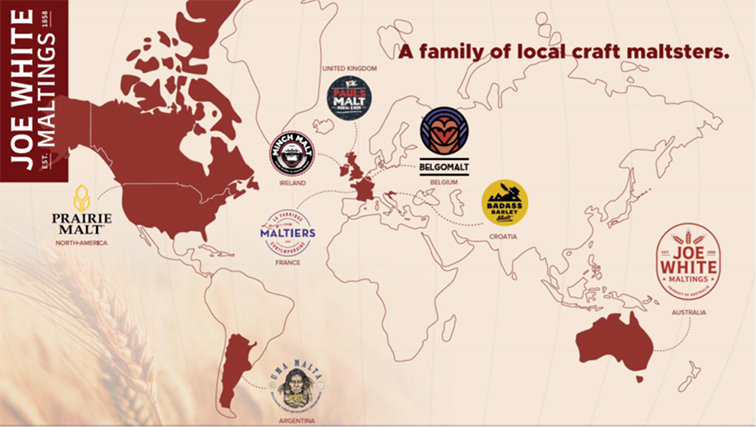Australian company Joe White Maltings, the second-largest barley producer in the world, has recently entered the Indian market. During his recent visit to the country, Daniel Baillon, Key Accounts Manager for Asia-Pacific, shares his views on India’s potential, the company’s commitment to craft brewers, the malting process behind their products, and why the region remains a strategic focus for the business. Excerpts from his conversation with Roy Thomas:
Could you introduce your company to our readers?
As the craft beer revolution continues to reshape beverage culture across the world, Joe White Maltings is positioning itself to play a pivotal role in Asia’s emerging brewing scenes. Founded in 1858, Joe White Maltings is the largest malting company in Australia and the second-largest supplier of malt in the world. It is a part of the Belgian Boortmalt group.
The company operates 10 malting plants across Australia, with a combined annual capacity of over 5,00,000 metric tonnes. It sources the finest Australian barley, known globally for its quality, and works in close collaboration with growers under sustainable and traceable systems.
Joe White Maltings supplies a wide portfolio of high-performance base and specialty malts to both global beer giants and independent craft breweries. Its reputation for technical consistency, flavour precision, and strong brewer partnerships has made it a staple across international markets.
What makes India an attractive market for you?
India has an energy and momentum around beer that reminds me of what we saw in some other fast-growing markets a few years ago. There’s a young population eager to try new things, a growing appreciation for taste and provenance, and a new generation of brewers who are experimenting and pushing boundaries.
That combination makes India incredibly exciting. From our perspective, it’s not just about finding a new customer base; it’s about being part of something transformative.
Brewers here are looking for suppliers who understand craft, who offer consistent quality, and who can collaborate. That’s what we bring to the table.
How does Joe White Maltings support the unique needs of craft brewers?
Craft brewers tend to work in smaller batches and often change their recipes or styles, depending on season or demand. That means they need malt that performs predictably and a supplier who is willing to work with them through that flexibility.
We have a team that works directly with brewers to ensure the malt is giving them the flavour, colour, extract and efficiency they need. We also offer technical support, recipe advice and guidance based on decades of experience.
When brewers run into challenges – whether it’s a haze issue in an IPA or a lack of foam stability in a lager – we can step in with data, experience and hands-on assistance.
That kind of support is especially valuable in newer markets where access to resources can still be limited. Our role is to make their brewing life easier, whether they’re scaling up or experimenting with something entirely new.
Can you walk us through the malting process?
Malting is about unlocking the enzymatic and fermentable potential of barley and converting it into a usable form for brewing. We guide raw barley through three carefully controlled stages: steeping, germination, and kilning.
In steeping, the barley absorbs water and begins to awaken. During germination, the grain begins to sprout and develops the enzymes needed to break down starches. Finally, kilning stops the process and sets the malt’s flavour, colour and moisture levels.
We primarily work with two-row barley, which is prized for its plumper kernels, lower protein levels, and higher extract potential. These are qualities that make it ideal for craft and premium brewing. Six-row barley has a higher enzyme content and is sometimes used in adjunct brewing, especially where brewers are incorporating non-barley grains like corn or rice.
The way we control temperature, airflow and timing during malting directly affects how a brewer’s mash behaves, how easily they extract sugars, the flavours they get, and the fermentation performance. That’s why malt is far from a commodity product – it’s a carefully crafted ingredient.
What varieties of your malts are most popular among craft brewers?
Our range includes both high-quality base malts and an extensive lineup of specialty malts. On the base malt side, brewers often choose from our Signature Pilsner, Traditional Ale or Wheat malts. These form the backbone of many beers and contribute essential fermentable sugars along with foundational flavour and mouthfeel.
In terms of specialties, we offer Munich malts for toasted, malty notes; Crystal and Cara malts for colour and caramel sweetness; Roasted Barley and Chocolate malt for deep coffee and cocoa tones; and Vienna and Light Crystal malts for complex layering.
Among craft brewers, our Signature series is a favourite, particularly with those making clean lagers or hop-driven ales. But we’re also seeing increasing demand for our roasted and wheat malt as brewers lean into haze-forward styles like NEIPAs or revisit traditional dark beer formats.

The company operates 10 malting plants across Australia, with a combined annual capacity of over 5,00,000 metric tonnes.
How do you serve your customers across Asia-Pacific?
Australia gives us real advantages in proximity and production environment. Logistically, it allows us to deliver fresher malt with shorter lead times and more agility in meeting customer needs. Compared to shipments from Europe or North America, we’re simply closer to the action. That helps brewers manage their supply chain more effectively.
Equally important is the quality of Australian barley. We’re fortunate to source from some of the world’s most renowned growing regions, including Western Australia, South Australia and Victoria. These areas produce barley with high extract potential, excellent enzyme content, and low moisture, making them ideal for malting.
Australia produces around 13 million tonnes of barley annually, and a significant portion of that is malting grade. Our traceability systems ensure that brewers know exactly where their malt came from and how it was handled, from farm to finished product.
What are the current trends and challenges across the region?
Brewers across Asia-Pacific are becoming more technically advanced and ambitious. They’re not just replicating Western styles, they’re redefining them with local ingredients and regional palates. We’re seeing interest in mixed fermentation, kettle sours, session-strength beers, and lagers with Asian adjuncts like rice, tea or tropical fruit.
At the same time, brewers face real constraints – rising raw material costs, changing import regulations, and the challenge of standing out in a crowded market. There’s a push towards greater efficiency without sacrificing quality. That’s where we see our role – not only in supplying malt but in being a technical partner who can help brewers get more out of every batch.
Sustainability is another growing focus. Brewers want to know their ingredients were produced responsibly. We’re addressing that through better traceability, carbon-conscious farming partnerships, and improvements in our own energy and water usage at the malting plants.
How can Indian brewers and distributors connect with Joe White Maltings?
We are excited to have tied up with Catalysts as our distribution partners in India. We welcome interest from anyone in the brewing ecosystem, be it a new micro-brewery or an established regional player.
Brewers can reach us via our website, social platforms, or through regional representatives. They can write to us at contact@joewhitemaltings.com.au.














